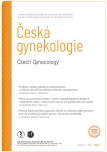-
Medical journals
- Career
Fluidothorax as an atypical symptom of late ovarian hyperstimulation syndrome
Authors: Hubka P.; Študent V.
Authors‘ workplace: Gynekologicko-porodnická klinika 1. LF UK a FN Bulovka, Praha
Published in: Ceska Gynekol 2022; 87(1): 40-42
Category: Case Report
doi: https://doi.org/10.48095/cccg202240Overview
Objective: To present a case of isolated fluidothorax as a symptom of atypical late ovarian hyperstimulation syndrome. Methods: Review of available information and presentation of our case observed at the Department of Obstetrics and Gynaecology, 1st Faculty of Medicine, Charles University and University Hospital Bulovka. GnRH antagonist protocol was used to stimulate the patient and fresh embryo transfer was performed. Sixteenth day after the oocyte retrieval the patient was examined due to dyspnoea and lab exam proved ovarian hyperstimulation syndrome. Conclusion: Late ovarian hyperstimulation syndrome can lead to isolated fluidothorax in case of additional favourable conditions.
Keywords:
ovarian hyperstimulation syndrome – hydrothorax
Sources
1. Kumar P, Sait SF, Sharma A et al. Ovarian hyperstimulation syndrome. J Hum Reprod Sci 2011; 4 (2): 70–75. doi: 10.4103/0974-1208.86080.
2. Golan A, Weissman A. Symposium: update on prediction and management of OHSS. A modern classification of OHSS. Reprod Biomed Online 2009; 19 (1): 28–32. doi: 10.1016/s1472 - 6483 (10) 60042-9.
3. Binder H, Dittrich R, Einhaus F et al. Update on ovarian hyperstimulation syndrome: part 1 – incidence and pathogenesis. Int J Fertil Womens Med 2007; 52 (1): 11–26.
4. Řežábek K. Assisted reproduction trends in Czech Republic National Assisted Reproduction Register 2007–2017. Ceska Gynekol 2020; 85 (1): 4–10.
5. Lyons CA, Wheeler CA, Frishman GN et al. Early and late presentation of the ovarian hyperstimulation syndrome: two distinct entities with different risk factors. Hum Reprod 1994; 9 (5): 792–799. doi: 10.1093/oxfordjournals.humrep.a138598.
6. Mathur RS, Akande AV, Keay SD et al. Distinction between early and late ovarian hyperstimulation syndrome. Fertil Steril 2000; 73 (5): 901–907. doi: 10.1016/s0015-0282 (00) 00492-1.
7. Al-Shawaf T, Grudzinskas JG. Prevention and treatment of ovarian hyperstimulation syndrome. Best Pract Res Clin Obstet Gynaecol 2003; 17 (2): 249–261. doi: 10.1016/s1521-6934 (02) 00127-x.
8. Mümüşoğlu S, Tanaçan A, Turan V et al. Ovarian hyperstimulation syndrome presenting with isolated unilateral right-side hydrothorax: a report of two cases and systematic review of the literature. Turk J Obstet Gynecol 2020; 17 (1): 65–72. doi: 10.4274/tjod.galenos.2019.89 656.
9. Tang HH, Tsai YC, Kang CY et al. Atypical ovarian hyperstimulation syndrome with isolated pleural effusion but without ascites or hemoconcentration. Taiwan J Obstet Gynecol 2007; 46 (2): 180–182. doi: 10.1016/S1028-4559 (07) 60016-3.
10. Aboulghar MA, Mansour RT, Serour GI et al. Autotransfusion of the ascitic fluid in the treatment of severe ovarian hyperstimulation syndrome. Fertil Steril 1992; 58 (5): 1056–1059. doi: 10.1016/s0015-0282 (16) 55459-4.
Labels
Paediatric gynaecology Gynaecology and obstetrics Reproduction medicine
Article was published inCzech Gynaecology

2022 Issue 1-
All articles in this issue
- Pregnancy outcome prediction after embryo transfer based on serum human chorionic gonadotrophin concentrations
- Contribution of ultrasound examination in the detection of unexpected uterine and adnexal findings in reconstructive surgery for pelvic organ prolapse
- Accuracy of the Edinburgh Postnatal Depression Scale in screening for major depressive disorder and other psychiatric disorders in women towards the end of their puerperium
- Intramyometrial pregnancy after hysteroscopic resection of retained products of conception – a case report
- Fluidothorax as an atypical symptom of late ovarian hyperstimulation syndrome
- Hand-foot-mouth disease in puerperium
- Brain abscess as a rare complication of pelvic inflammatory disease
- Indocyanine green as a new trend in sentinel lymphatic node detection in oncogynecology
- Domestic violence in the clinical practice of gynecologists and obstetricians
- Preliminary cost variance modeling to compare autologous intraovarian platelet-rich plasma vs. standard hormone replacement therapy for menopause management
- Fetal neck giant hemangioma associated with postnatal arising Kasabach-Merritt syndrome
- Czech Gynaecology
- Journal archive
- Current issue
- Online only
- About the journal
Most read in this issue- Pregnancy outcome prediction after embryo transfer based on serum human chorionic gonadotrophin concentrations
- Accuracy of the Edinburgh Postnatal Depression Scale in screening for major depressive disorder and other psychiatric disorders in women towards the end of their puerperium
- Hand-foot-mouth disease in puerperium
- Indocyanine green as a new trend in sentinel lymphatic node detection in oncogynecology
Login#ADS_BOTTOM_SCRIPTS#Forgotten passwordEnter the email address that you registered with. We will send you instructions on how to set a new password.
- Career

